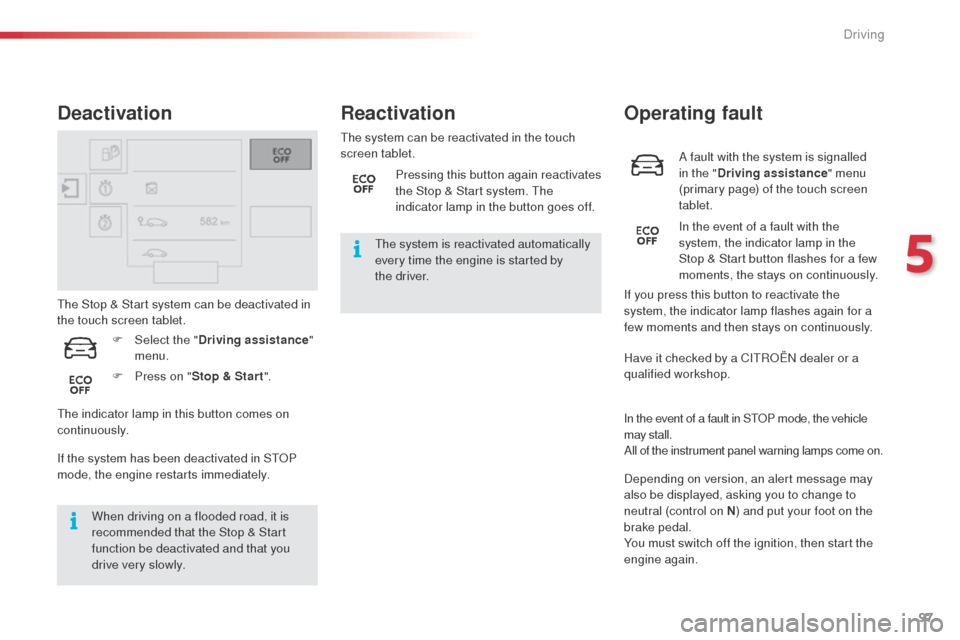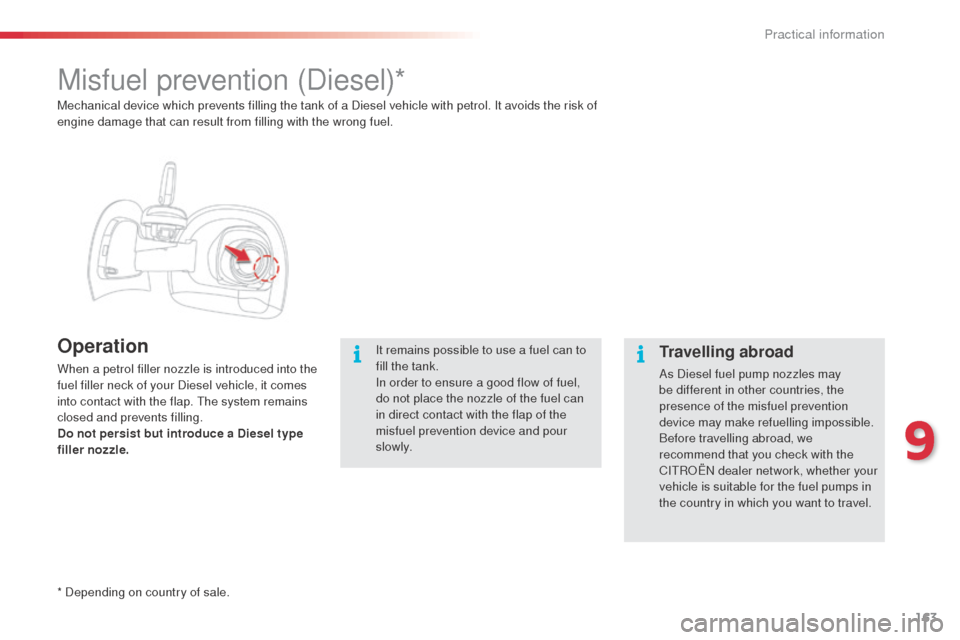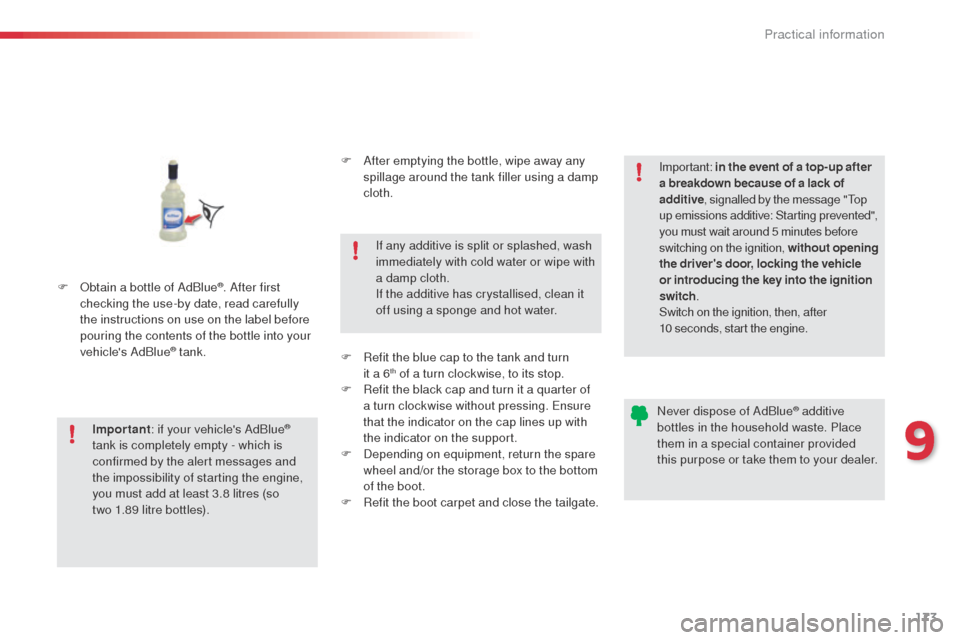check engine Citroen C4 CACTUS RHD 2014 1.G User Guide
[x] Cancel search | Manufacturer: CITROEN, Model Year: 2014, Model line: C4 CACTUS RHD, Model: Citroen C4 CACTUS RHD 2014 1.GPages: 331, PDF Size: 8.56 MB
Page 95 of 331

93
Before switching off the engine:
- p ress control N to be in neutral,
or
-
l
eave the vehicle in gear; in this case the
vehicle cannot be moved.
Stopping the vehicle
For all parking situations, you must
apply the parking brake to immobilise
the vehicle.
When immobilising the vehicle with
the engine running, you must select
neutral
N.
Operating fault
- - - appears in the instrument panel.
F
P
ress control N .
F
P
ress the brake pedal.
F
W
ait for around 30 seconds until N or a
gear appears in the instrument panel.
F
P
ress control D , then N.
F
W
ith your foot still on the brake pedal, start
the engine.
The gearbox is operational again.
Reinitialisation
(5-speed electronic
gearbox)
Following disconnection of the battery, it is
necessary to reinitialise the gearbox.
F
S
witch on the ignition.
In exceptional circumstances, the
gearbox may need an automatic
reinitialisation: starting and gear
changing are no longer possible.
- - - appears in the instrument panel.
Follow the procedure described above.
Before doing anything under the bonnet,
ensure that control N has been pressed
and that the parking brake is applied. With the ignition on, illumination of
this warning lamp, accompanied by
an audible signal and a message,
indicates a gearbox fault.
Have it checked by a CITROËN dealer or a
qualified workshop.
5
Driving
Page 96 of 331

94
Hill start assist
System which keeps your vehicle immobilised
temporarily (approximately 2 seconds) when
starting on a gradient, the time it takes to
move your foot from the brake pedal to the
accelerator pedal.
This system only operates when:
-
t
he vehicle is completely stationary, with
your foot on the brake pedal,
-
c
ertain conditions of slope are met,
-
w
ith the driver’s door closed.
The hill start assist system cannot be
deactivated.
On an ascending slope, with the vehicle
stationary, the vehicle is held momentarily when
you release the brake pedal, provided that:
- you are in first gear or neutral with a manual gearbox,
-
y
ou are in position D with an electronic
gearbox.
Operation
On a descending slope, with the vehicle
stationary and reverse gear engaged, the
vehicle is held momentarily when you
release the brake pedal.
Operating fault
If a fault in the system occurs, these warning
lamps come on, accompanied by an alert
message. Contact a CITROËN dealer or
a qualified workshop to have the system
checked.
Do not leave the vehicle while it is being
held in the hill start assist phase.
If you need to exit the vehicle with
the engine running, apply the parking
brake.
Driving
Page 99 of 331

97
A fault with the system is signalled
in the "Driving assistance " menu
(primary page) of the touch screen
tablet.
Operating fault
In the event of a fault with the
system, the indicator lamp in the
Stop & Start
button flashes for a few
moments, the stays on continuously.
If you press this button to reactivate the
system, the indicator lamp flashes again for a
few moments and then stays on continuously.
The Stop & Start system can be deactivated in
the touch screen tablet.
Deactivation
If the system has been deactivated in STOP
mode, the engine restarts immediately.
When driving on a flooded road, it is
recommended that the Stop & Start
function be deactivated and that you
drive very slowly. The system can be reactivated in the touch
screen tablet.
Reactivation
The system is reactivated automatically
every time the engine is started by
the
driver.
F
P
ress on " Stop & Star t ".
F
Sel
ect the " Driving assistance "
menu.
The indicator lamp in this button comes on
continuously. Pressing this button again reactivates
the Stop & Start system. The
indicator lamp in the button goes off.
Have it checked by a CITROËN dealer or a
qualified workshop.
In the event of a fault in STOP mode, the vehicle
may stall.
All of the instrument panel warning lamps come on.
Depending on version, an alert message may
also be displayed, asking you to change to
neutral (control on N) and put your foot on the
brake pedal.
You must switch off the ignition, then start the
engine again.
5
Driving
Page 114 of 331

112
In bad weather and in winter, ensure
that the sensors are not covered by
road dirt, ice or snow.
In the event of a fault, have the system
checked by a CITROËN dealer or a
qualified workshop.
If the system is deactivated during a
manoeuvre, the drive should reactivate
it manually to repeat the measurement. If the lateral distance between your vehicle
and the space is too great, the system may
not be able to measure the space.
Anything projecting beyond the envelope
of the vehicle (long or wide load) is not
taken into account by the Park Assist
system during a manoeuvre.
Deactivation
A message is displayed in the screen.
The driver then takes back control of the
vehicle's steering.
The system is deactivated automatically:
-
o
n switching off the ignition,
-
i
f the engine stalls,
-
i
f no manoeuvre is started within 5 minutes
of selection of the type of manoeuvre,
-
a
fter a prolonged stop of the vehicle during
a manoeuvre,
-
i
f the road wheel anti-spin regulation (ASR)
system is invoked,
-
i
f the speed of the vehicle exceeds the
stated limit,
-
w
hen the driver interrupts movement of the
steering wheel,
-
i
f the driver presses the Park Assist control
(or the Park Assist button of the Driving
assistance menu in the touch screen
tablet),
-
i
f correct positioning of the vehicle is not
possible (too many manoeuvres needed to
insert or extract the vehicle),
-
i
f the driver's door is open,
-
i
f one of the front wheels encounters an
obstacle.
Switching off
The system is switched off automatically:
- w hen towing a trailer,
-
i
f the driver's door is opened,
-
i
f the speed of the vehicle is above 42 mph
(70 km/h).
To switch the system of for a prolonged period,
contact a CITROËN dealer or a qualified
workshop.
Operating faults
In the event of a fault with the
system, this warning lamp is
displayed in the instrument panel and/or a
message appears in the screen, accompanied
by an audible signal (short beep).
The indicator lamp in the control flashes for a
few seconds. If the problem occurs while using
the system, the indicator lamp goes off.
Contact a CITROËN dealer or a qualified
workshop.
Driving
Page 138 of 331

136
Dynamic stability control (DSC)
and anti-slip regulation (ASR)The DSC system offers exceptional
safety in normal driving, but this should
not encourage the driver to take extra
risks or drive at high speed.
The correct operation of the system
depends on observation of the
manufacturer's recommendations
regarding the wheels (tyres and rims),
the braking components, the electronic
components and the assembly and
repair procedures used by CITROËN
dealers.
After an impact, have the system
checked by a CITROËN dealer or a
qualified workshop.
Activation
These systems are activated automatically
each time the vehicle is started.
As soon as they detect a problem of grip or
trajectory, these systems act on the operation if
the engine and brakes.
Deactivation
In exceptional conditions (starting a vehicle
which is bogged down, stuck in snow, on soft
ground...), it may be advisable to deactivate
the DSC system, so that the wheels can move
freely and regain grip.
This is indicated by flashing of this
warning lamp in the instrument panel.
Operating fault
But it is recommended that the system be
reactivated as soon as possible. F
P
ress the button.
This warning lamp and the indicator lamp
in the button come on: the DSC system no
longer acts on the operation of the engine.
Reactivation
The system is reactivated automatically each
time the ignition is switched back on or from
30 mph (50 km/h). F
P
ress the button again to
reactivate it manually. If this warning lamp comes on,
accompanied by an audible signal
and a message, this indicates a fault
with the system.
Contact a CITROËN dealer or a qualified
workshop to have the system checked.
Safety
Page 165 of 331

163
Misfuel prevention (Diesel)*
Operation
When a petrol filler nozzle is introduced into the
fuel filler neck of your Diesel vehicle, it comes
into contact with the flap. The system remains
closed and prevents filling.
Do not persist but introduce a Diesel type
filler nozzle.
* Depending on country of sale. Mechanical device which prevents filling the tank of a Diesel vehicle with petrol. It avoids the risk of
engine damage that can result from filling with the wrong fuel.It remains possible to use a fuel can to
fill the tank.
In order to ensure a good flow of fuel,
do not place the nozzle of the fuel can
in direct contact with the flap of the
misfuel prevention device and pour
s l ow l y.Travelling abroad
As Diesel fuel pump nozzles may
be different in other countries, the
presence of the misfuel prevention
device may make refuelling impossible.
Before travelling abroad, we
recommend that you check with the
CITROËN dealer network, whether your
vehicle is suitable for the fuel pumps in
the country in which you want to travel.
9
Practical information
Page 171 of 331

169
In the event of a fault with the the SCR emissions control system
In the event of the detection
of a faultDuring an authorised driving phase (between
650 miles and 0 miles) (1 100 km and 0 km)
A system that prevents engine starting is
activated automatically from 650 miles
(1 100 km) after confirmation of a fault
with the SCR emissions control system.
Have the system checked by a CITROËN
dealer or a qualified workshop as soon as
possible.
If it is a temporary fault, the alert
disappears once the exhaust gas
emissions return to normal.
When switching on the ignition, the UREA,
SERVICE and diagnostic warning lamps comes
on, accompanied by an audible signal and the
display of a message "Emissions fault" to signal
a fault with the emissions control system.
If a fault with the SCR system is confirmed
(after 30 miles (50 km) covered with the
permanent display of the message signalling
a fault), when switching on the ignition, the
SERVICE and engine diagnostic warning lamps
come on and the UREA warning lamp flashes,
accompanied by an audible signal and the
display of a message (e.g.: "Emissions fault:
Starting prevented in 150 miles") indicating the
remaining range express in miles or kilometres.
While driving, the message is displayed every
30 seconds while the fault with the SCR system
persists.
You should go to a CITROËN dealer or a
qualified workshop as soon as possible.
If you fail to do this, there is a risk that you will
not be able to start your engine.
9
Practical information
Page 175 of 331

173
F Obtain a bottle of AdBlue®. After first
checking the use-by date, read carefully
the instructions on use on the label before
pouring the contents of the bottle into your
vehicle's AdBlue
® tank.
Important : if your vehicle's AdBlue
®
tank is completely empty - which is
confirmed by the alert messages and
the impossibility of starting the engine,
you must add at least 3.8 litres (so
two 1.89 litre bottles). If any additive is split or splashed, wash
immediately with cold water or wipe with
a damp cloth.
If the additive has crystallised, clean it
off using a sponge and hot water.
Important:
in the event of a top-up after
a breakdown because of a lack of
additive , signalled by the message "Top
up emissions additive: Starting prevented",
you must wait around 5 minutes before
switching on the ignition, without opening
the driver's door, locking the vehicle
or introducing the key into the ignition
switch .
Switch on the ignition, then, after
10
seconds, start the engine.
Never dispose of AdBlue
® additive
bottles in the household waste. Place
them in a special container provided
this purpose or take them to your dealer.
F
A
fter emptying the bottle, wipe away any
spillage around the tank filler using a damp
cloth.
F
R
efit the blue cap to the tank and turn
it a 6
th of a turn clockwise, to its stop.
F
R
efit the black cap and turn it a quarter of
a turn clockwise without pressing. Ensure
that the indicator on the cap lines up with
the indicator on the support.
F
D
epending on equipment, return the spare
wheel and/or the storage box to the bottom
of the boot.
F
R
efit the boot carpet and close the tailgate.
9
Practical information
Page 182 of 331

180
Checking tyre pressures /
inflating accessories
You can also use the compressor, without
injecting any product, to:
-
c
heck or adjust the pressure of your tyres,
-
i
nflate other accessories (balls, bicycle
tyres...).
F
T
urn the selector A to the "Air"
position.
F
U
ncoil the black pipe H fully. F
C onnect the compressor's electrical
connector to the vehicle's 12 V socket.
F
S
tart the vehicle and let the engine run.
F
A
djust the pressure using the compressor
(to inflate: switch B in position "I" ; to
deflate: switch B in position "O" and press
button C ), according to the vehicle's tyre
pressure label or the accessory's pressure
label.
F
R
emove the kit then stow it.Should the pressure of one or more
tyres be adjusted, it is necessary to
reinitialise the under-inflation detection
system.
Refer to the "Under-inflation detection"
section.
F
C
onnect the black pipe to the valve of the
wheel or accessory.
I
f necessary, fit one of the adaptors
supplied with the kit first.
Practical information
Page 205 of 331

203
12 V battery
The battery is located under the bonnet.
For access to the (+) terminal:
F
r
elease the bonnet using the interior lever,
then the exterior safety catch,
F
r
aise the bonnet and secure it with its stay,
F
l
ift the plastic cover for access to the (+)
terminal.
Access to the battery
Procedure for starting the engine using another battery or charging a discharged battery.
The presence of this label, in particular
with the Stop & Start system, indicates
the use of a 12 V lead-acid battery with
special technology and specification;
the involvement of a CITROËN dealer
or a qualified workshop is essential
when replacing or disconnecting the
battery.
After refitting the battery, the Stop &
Start system will only be active after a
continuous period of immobilisation of the
vehicle, a period which depends on the
climatic conditions and the state of charge
of the battery (up to about 8 hours).
Before doing any work
Immobilise the vehicle: apply the
parking brake, put the gearbox in
neutral, then switch off the ignition.
Check that all electrical equipment is
switched off.
9
Practical information